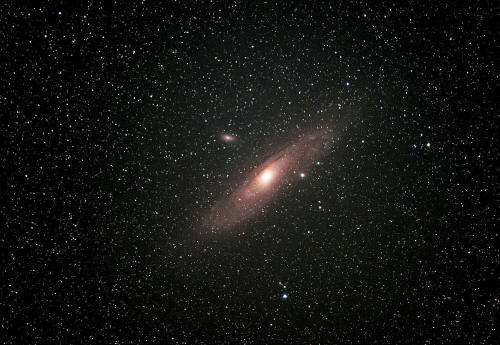|

by Joe Rao
November 28, 2015
from
Space Website
|
Joe Rao serves as
an instructor and guest lecturer at New York's Hayden
Planetarium.
He writes about
astronomy for Natural History magazine, the Farmer's
Almanac and other publications, and he is also an
on-camera meteorologist for News 12 Westchester, N.Y.
|

This
spectacular image of the Andromeda Galaxy (M31)
was captured by Greg
Redfern, the "Sky Guy.”
Credit: Greg Redfern
In my opinion - and this of course is purely subjective - the most
popular object that people like to view through a telescope is the
moon.
Number two is probably the ringed planet Saturn. As far as third
place is concerned, I would say it's a toss-up. Everyone enjoys
looking at Jupiter, with its complex cloud belts, the famous Great
Red Spot and four big satellites.
However, if it's autumn and the sky is reasonably dark and clear,
with no bright moon to obscure the fainter stars, then another
object makes its way into this conversation:
The great Andromeda galaxy.
Beloved
(albeit fuzzy) sky attraction
The following question has floated out of the darkness many times at
outdoor star parties I've attended:
"Hey! Can you show us that galaxy?"
"That galaxy" always refers to
Andromeda, which is also known as M31 in Charles Messier's famous
catalogue of galaxies, nebulae and star clusters. Andromeda is the
nearest major galaxy to our own Milky Way, as well as the largest
and most massive galaxy in the so-called 'Local Group':
Local Group
Source
The 'Local Group' is the galaxy group that includes the Milky Way.
The Local Group comprises more than
54 galaxies, most of them dwarf galaxies. Its gravitational
center is located somewhere between the Milky Way and the
Andromeda Galaxy.
The Local Group covers a diameter of
10 Mly (3.1 Mpc) and has a binary (dumbbell) distribution. The
group itself is a part of the larger
Laniakea Supercluster
(i.e., the Local Supercluster).
The local supercluster was
previously thought to be the Virgo Supercluster, now an
appendage to the newly defined local supercluster.
The two most massive members of the group are,
-
the Milky Way galaxy
-
the Andromeda galaxy
These two spiral galaxies have each
a system of satellite galaxies.
Milky Way's satellite galaxies system comprises,
-
Sagittarius Dwarf Galaxy
-
Large Magellanic Cloud
-
Small Magellanic Cloud
-
Canis Major Dwarf
-
Ursa Minor Dwarf
-
Draco Dwarf
-
Carina Dwarf
-
Sextans Dwarf
-
Sculptor Dwarf
-
Fornax Dwarf
-
Leo I
-
Leo II
-
Ursa Major I Dwarf
-
Ursa Major II Dwarf,
...plus several additional
ultra-faint dwarf spheroidal galaxies.
The Andromeda Galaxy's satellite system consists of,
...plus several additional
ultra-faint dwarf spheroidal galaxies.
The
Triangulum Galaxy, the third largest and only unbarred
spiral galaxy in the Local Group, may or may not be a companion
to the Andromeda Galaxy.
Pisces Dwarf is equidistant from the
Andromeda Galaxy and the Triangulum Galaxy, so it may be a
satellite of either.
The membership of
NGC 3109, with its companions Sextans A and
the Antlia Dwarf, is uncertain due to extreme distances from the
center of the Local Group.
The other members of the group are gravitationally secluded from
these large subgroups:
The spiral Andromeda galaxy can be a
truly awe-inspiring night-sky sight.
For example, in the second volume of his
two-volume autobiography, "In Joy Still Felt" (Doubleday, 1980), the
late biochemist and sci-fi author Isaac Asimov described when
he and his wife Janet signed up for an astronomy-themed cruise:
"It was a beautiful mild night, and
the sky was more splendid than a planetarium dome could have
been. Janet used her binoculars to look at the objects
described, and the high point came when we saw the Andromeda
galaxy for the first time.
If the cruise had ended at that
point, we would have had our money's worth."
Little cloud,
big galaxy
And yet, to the naked eye, Andromeda doesn't look like much - a
wispy, hazy blotch that resembles a fuzzy star.
But when you realize exactly what you're
looking at, you can forgive the galaxy for being so dim and
tired-looking.
The first definitive observation of Andromeda came more than 1,000
years ago. In the year 964 A.D., the Persian astronomer Abd al-Rahman
al-Sūfī drew attention to a "little cloud" located among the
stars of the constellation Andromeda, the Chained Princess.
Observations by NASA's
Spitzer Space Telescope suggest
that "little cloud" actually gives off the light of 1 trillion stars
- five to 10 times more than our Milky Way possesses. And at its
widest, Andromeda is about 220,000 light-years across (the disk of
the Milky Way is about 100,000 light-years wide.)
These are indeed impressive figures, but the one factoid that is
truly mind-blowing concerns Andromeda's distance - 2.5 million
light-years.
The Andromeda galaxy is the farthest object that your eyes can see
without the aid of binoculars or a telescope. If you view it tonight
(and I'll show you how to find it in a moment), consider that the
light from this wispy object traveled 2.5 million years to reach
your eyes, traveling all that time at the tremendous velocity of
186,282 miles (299,792 kilometers) per second.
That light therefore began its journey around the time of the dawn
of human consciousness, when mastodons and saber-toothed tigers
roamed over much of pre-ice-age North America and prehistoric man
struggled for existence in what is now the
Olduvai Gorge of East Africa.
How to find it
So, how can you spot this beautiful galaxy?
This upcoming week will be a good time
to try, because the dazzlingly bright moon that dominated our
evening sky this past week is now rising progressively later each
evening.
Tonight (Nov. 27), for example, the moon rises at 6:40 p.m. By Nov.
30, it's rising three hours later, and by Dec. 4, it's not up until
half-past midnight. So the moon will be less and less of hindrance
as the week progresses.
So step outside between 7 and 9 p.m. local time, face
south-southwest and look about three-quarters of the way up from the
horizon to the point directly overhead. You'll take note of four
bright stars; they form the Great Square of Pegasus, one of the
landmarks of the sky.
Now imagine that the Square is the bowl of a large dipper, and look
for its handle extending out from the star in the upper left corner
of the Square. That star is
Alpheratz.
Three bright stars form this handle,
including Alpheratz. These three - the other two are called
Mirach and
Almach - are almost evenly spaced
and are about as far apart as the stars of the Square itself.
Incidentally,
...belong to the
constellation Andromeda.
Above the middle star of the handle (Mirach) are two fainter stars
nearly in line with it. Near the northern star, if your sky is clear
and dark, you can spy a hazy patch of light, almost directly
overhead. (If you can't see it with your unaided eyes, use
binoculars.)
Focus on Mirach, then scan above it
until you find that hazy patch.
And there it is -
Andromeda Galaxy...!
The darker,
the better
The galaxy can actually be a bit of a disappointment through
binoculars or a good telescope.
Andromeda often appears as little more
than an elongated fuzzy patch, which gradually brightens in
the center to a star-like nucleus.
Don't expect to see individual stars; only a long-exposure
photograph will bring them out. Once, however, in August 1975, on an
exceptionally clear and dark night at the annual Stellafane
convention near Springfield, Vermont, I was able to glimpse the
galaxy's dark dust lanes through a homemade 6-inch (15 centimeters)
"rich field" telescope.
And in very dark skies, one can see the galaxy take on incredible
dimensions.
Careful binocular estimates by the
French astronomer Robert Jonckheere in the 1950s gave a
length of just over 5 degrees and a width of just over 1 degree. For
comparison, the "pointer" stars at the end of the Big Dipper's bowl
are separated by just over 5 degrees, and the full moon is only 0.5
degrees wide!
Admittedly, to make this measurement, Jonckheere did use "giant"
binoculars with 2-inch (5 cm) lenses, with the oculars centered so
that both of his pupils were fully used. He also had dark-adapted
his eyes for 10 minutes with the exclusion of all light except from
Andromeda itself.
The message is clear:
The darker and more transparent the
sky, the more impressive the view.
Good luck!
|


